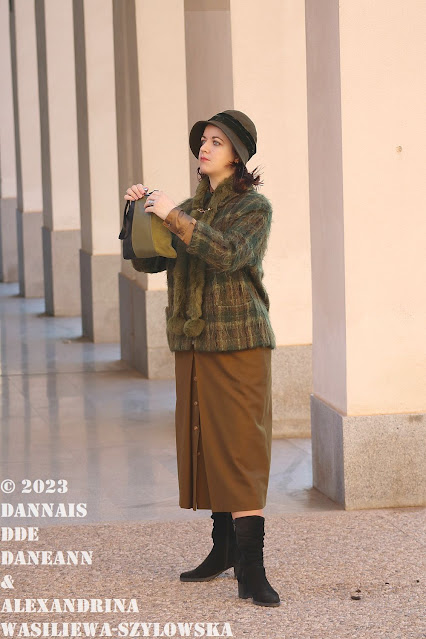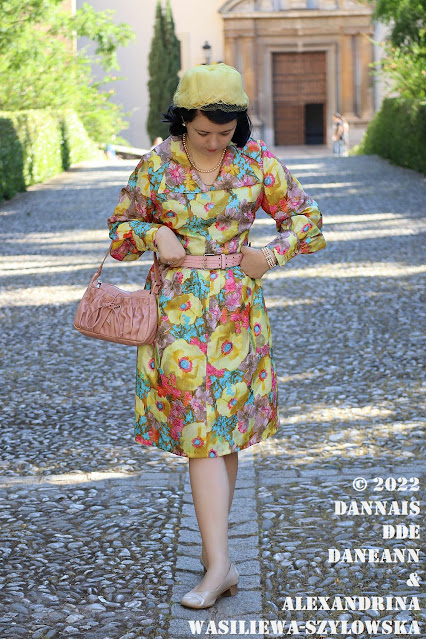Archive of 2022-2023: Warm winter outfit in style of the 1924
Moreover, at the beginning of that decade, they were very long in general. Cloche hats were certainly in fashion, but they were not the only ones. This is also one of the clichés of nowdays to consider that, apart from the cloche hat, they wore no any other headgears. In fact, if you look at the hat magazines of those times, you can see that this was not so. Even more, in several issues I have looked through, the cloche hat was not mentioned even once. Turbans and elaborate hats in medieval and traditional styles were in fashion.
However, since it is difficult to get such hats, I show you a vintage, but not truly 1920s. It is a more modern version of cloche hats. I paired it with a long and loose zip-up jacket and a button-down midi skirt.
Maybe a zipper jacket doesn't quite fit the 1920s look. While a zipper on clothes is a common thing nowdays, it is a very controversial invention, we should not assume we know everything about. In fact, to my mind, someone could have made clothes with it in those days.
For example, there is a belief among vintage collectors that plastic or nylon zippers were not in clothing until the 1970s. It is possible that this was the case in the United States, but not over the World. In the Eastern Bloc and Europe, plastic or nylon zippers were already in existence in the 1950s, and possibly earlier. My great-grandmother was engaged in sewing clothes for herself and her loved ones. I know for sure that in the 1950s she sewed a plastic zipper into her skirt. So some of my vintage European clothes from the 1950s have plastic zippers.
By the way, the belief that the zipper located on the back should indicate the 1950s, 1960s, or the present days is also erroneous. I have a lot of clothes from the 1950s and 1960s that have the zipper on the side. And the same also was in a lot of modern clothes, among which only one dress had the zipper located on the back, but in the rest on the side and only on the side.
I am not a fan of zippers because they have so many flaws. Plastic ones are very weak, especially modern ones. They break easily, and fabric constantly stucks into them. Metal ones look more solid and better, but they sometimes unfasten. And fabric also stucks into them. Yet, I like metal zippers more than plastic ones. But in general ... in my opinion, the best are buttons, hooks, lacing.
But what does history say about the clothes zipper?
The first idea for a fastener that has a common design with a modern zipper came to the mind of the inventor of the sewing machine, the American mechanic Elias Howe. He called his invention "automatic endless fastener for clothes" and patented it in 1851. It is said that it bore little resemblance to a modern zipper. It had two chains with hooks and holes that clung to each other with the help of a movable metal "tongue" in the form of a paper clip. However, the clasp did not get any commercial success, partly because Elias Howe was too busy working on a sewing machine. After all, it was his life's work. And his invention seemed unreliable to the general public and did not gain popularity.
Almost half of a century had passed, and the clasp, very similar to the invention of Elias Howe, was re-invented by the American inventor Whitcomb L. Judson in 1891, who filed a patent in 1893. He presented his invention at the World Exhibition in his hometown, Chicago. In those years, women shoes with a high top, fastened with many buttons, were very fashionable.
Therefore, Whitcomb L. Judson believed that ladies would pick up his invention, appreciating the convenience, simplicity and speed of fastening and unfastening shoes. But he was wrong. It is believed that for the reason that his clasp had the peculiarity of suddenly unfastening. Although this invention was yet not very clear to the general public and did not gained much popularity, it was Whitcomb L. Judson who received the title of "father of the sewing clasp-locker". The term "zipper" did not exist in those days. This name appeared much later as discussed below.
And finally, only in 1913, a Swedish-American electrical engineer Gideon Sundback, who had been working on improving fasteners for many years, patented the same clasp-locker that everyone knows now. So the modern zipper was born in December 1913 and was patented 4 years later - in 1917.
Sundback also took care of production: he developed and implemented a machine specifically for his invention. A year after its inception, the Sundback machine was already producing several hundred fasteners daily.
But although Gideon Sundback managed to make a functional and fairly high-quality version of the zipper, it was not easy to convince light industry manufacturers to start using it in production because everyone had already heard about the unsuccessful previous versions of the fastener.

The turning point came thanks to the B. F. Goodrich Company, a well-known tire manufacturer. In 1923, the Ohio plant owned by Benjamin Franklin Goodrich decided to expand its product range to include zip-up rubber boots (galoshes, overshoes) in addition to tires. For the product itself, manufacturers have come up with the enticing name "Mystic Boot", and Hookless’s “separable fastener” has been renamed to "Zipper". In the sound of this word, for English speakers, one hears an imitation of the sound of a zipper being unfastened and fastened (z z z i i ip). From here come names so popular in the English-speaking environment - North American "zipper", UK "zip" or "zip-fastener".
In 1923, during a trip to Europe, Gideon Sundback sold his European rights to Martin Othmar Winterhalter, who made his own amendments to the existing design. It was only after this date the fasteners began to be mass-produced, first in Germany and then in Switzerland.
One of the co-owners of the Hermes Brothers brand, Émile-Maurice Hermes, received two-year exclusive rights to use the zipper in leather goods and clothing, bringing this development from abroad and becoming the first person in France to introduce it to the public.

It was the Hermes company that designed a leather golf jacket with a zipper especially for the Prince of Wales Edward. Thanks to the exclusive rights, the zipper became known in France as the "Hermes clasp".
It took more than 20 years for the general public to "test" the novelty. It was not until the 1930s that children's clothing manufacturers began to promote the zipper. According to them, it was many times more convenient than buttons, adapted to awkward children's fingers that could handle with it alone. Although, in my opinion, the manufacturers were cunning, personally, my zippers always jam because fabric gets into them. And runners break very often. But back to history.
The Parisian fashion designer Elsa Schiaparelli, the creator of the ready-to-wear style, was the first who began to use the zipper in "civilian" clothes. Therefore, zipper appeared on women skirts and dresses much earlier than on men trousers. It wasn't until 1937 that the zipper finally caught the attention of French fashion designers, Jean Claude among them, and Esquire magazine called it "the latest idea for men clothing" and "the best thing that happened to men trousers." From that moment on, it could be considered that the zipper was firmly established.
Also in 1937, "Hookless Fastener" company changed its name to "Talon Inc".
Judging by old photographs, the zipper first appeared in the former USSR in the design of costumes for the theatrical production of Mayakovsky's «The Bedbug» («Klop»), as an element of futuristic clothing, staged by Vsevolod Meyerhold already in 1929.
In general, in the USSR, the zipper appeared in clothes back in the early 1930s, where men - workers and athletes - fell in love with it with might and main, and since 1941 soldiers began to wear clothes with it. In old photographs, you can see both civilian and military clothes with zippers. Moreover, the so-called "break fasteners" - as they were called in the USSR - had their own patents there.
Here is such a rich history of such, in my opinion, unsightly invention as a zipper.
I am wearing:
- Olive/hakki/mustard/black wool/mohair blend swing jacket with zipper front and 7/8 length sleeves by “Olsen Collection” (sold at “Ramon Hernandez San Sebastian”), made in Italy, about 1990s-2000s
- Mustard stretch silk long sleeve button down blouse by “Talking French”, about 2000s-2010s
- Real vintage mustard pure wool button down midi skirt by “Egger Moden”, made in Austria, about 1970s
(not seen) Light brown silk below knee length straight petticoat, about 2000s-2010s
- Real vintage olive green pure wool felt cloche hat with dark green velvet décor, made in England, about 1980s
- Green rabbit fur neckpiece, about 2000s-2010s
- Real vintage gold toned metal cardigan/stole clip with hands & "CD" initials ornament, about 1940s
- (not seen) Real vintage green cotton belt with silver toned metal Art Nouveau style floral shaped buckle, made in Germany, about 1970s-1980s
- Artisanal handmade black/olive/green leather/suede handbag with metal closure, about 2000s
- Beige nylon tights, about 2010s-2020s
- Black suede high boots with mid-high heels, 2010s-2020s, made in Spain
I think I ended up with a 1924 style outfit. More true to life than the refined blogger recommendations for dressing in 1920s fashion in a purely modern fashion. Any real lady of those times could well dress like that. Even despite the innovative for 1924 jacket with a zipper.
What do you think? Write your thoughts in the comments, I would be very interested to hear your opinion!












































Comments
Post a Comment